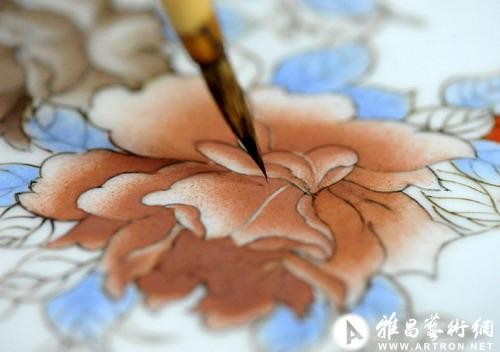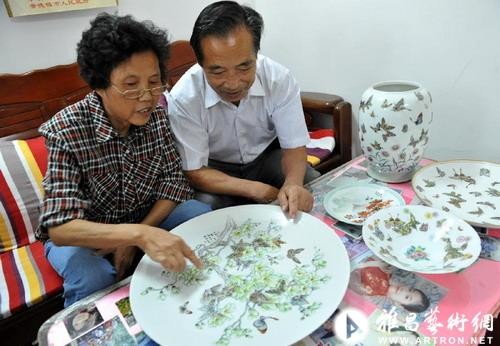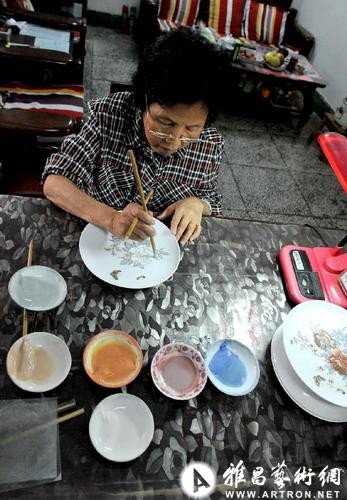
Fencai painting, a porcelain coloring technique, developed in China's Jingdezhen
2011-10-08 09:50:42 未知

Porcelain painter Xiang Qiaoyun painted on a ceramic plate with Fencai painting, a coloring technique developed in Yongzheng period (1722-1735) of Qing Dynasty, in Jingdezhen, east China's Jiangxi Province, Sept. 27, 2011. Fencai painting, known as soft pigment, was built upon the foundation of Wucai porcelain of Kangxi period (1661-1722) of Qing Dynasty and derived from enamel coloring. Opposite of Wucai's strong and bright tones, Fencai is well-known for its soft and soothing color, which is favorably used on images of flowers and butterflies. (Xinhua/Zhang Wu)

Porcelain painter Xiang Qiaoyun and her husband talk about Fencai painting, a coloring technique developed in Yongzheng period (1722-1735) of Qing Dynasty, in Jingdezhen, east China's Jiangxi Province, Sept. 27, 2011. Fencai painting, known as soft pigment, was built upon the foundation of Wucai porcelain of Kangxi period (1661-1722) of Qing Dynasty and derived from enamel coloring. Opposite of Wucai's strong and bright tones, Fencai is well-known for its soft and soothing color, which is favorably used on images of flowers and butterflies. (Xinhua/Zhang Wu)

Porcelain painter Xiang Qiaoyun painted on ceramic plates with Fencai painting, a coloring technique developed in Yongzheng period (1722-1735) of Qing Dynasty, in Jingdezhen, east China's Jiangxi Province, Sept. 27, 2011. Fencai painting, known as soft pigment, was built upon the foundation of Wucai porcelain of Kangxi period (1661-1722) and derived from enamel coloring. Opposite of Wucai's strong and bright tones, Fencai is well-known for its soft and soothing color, which is favorably used on images of flowers and butterflies. (Xinhua/Zhang Wu)

Photo taken on Sept. 27, 2011 shows a porcelain plate painted with Fencai painting, a coloring technique developed in Yongzheng period (1722-1735) of Qing Dynasty, in Jingdezhen, east China's Jiangxi Province. Fencai painting, known as soft pigment, was built upon the foundation of Wucai porcelain of Kangxi period (1661-1722) of Qing Dynasty and derived from enamel coloring. Opposite of Wucai's strong and bright tones, Fencai is well-known for its soft and soothing color, which is favorably used on images of flowers and butterflies. (Xinhua/Zhang Wu)

Photo taken on Sept. 27, 2011 shows a porcelain plate displaying magnolias and butterflies, painted with Fencai painting, a coloring technique developed in Yongzheng period (1722-1735) of Qing Dynasty, in Jingdezhen, east China's Jiangxi Province. Fencai painting, known as soft pigment, was built upon the foundation of Wucai porcelain of Kangxi period (1661-1722) of Qing Dynasty and derived from enamel coloring. Opposite of Wucai's strong and bright tones, Fencai is well-known for its soft and soothing color, which is favorably used on images of flowers and butterflies. (Xinhua/Zhang Wu)

Porcelain painter Xiang Qiaoyun painted on ceramic plates with Fencai painting, a coloring technique developed in Yongzheng period (1722-1735) of Qing Dynasty, in Jingdezhen, east China's Jiangxi Province, Sept. 27, 2011. Fencai painting, known as soft pigment, was built upon the foundation of Wucai porcelain of Kangxi period (1661-1722) of Qing Dynasty and derived from enamel coloring. Opposite of Wucai's strong and bright tones, Fencai is well-known for its soft and soothing color, which is favorably used on images of flowers and butterflies. (Xinhua/Zhang Wu)
(责任编辑:张天宇)
注:本站上发表的所有内容,均为原作者的观点,不代表雅昌艺术网的立场,也不代表雅昌艺术网的价值判断。
 阿拉里奥画廊上海转型:为何要成为策展式艺术商业综合体?
阿拉里奥画廊上海转型:为何要成为策展式艺术商业综合体? 李铁夫冯钢百领衔 作为群体的早期粤籍留美艺术家
李铁夫冯钢百领衔 作为群体的早期粤籍留美艺术家 春雨斋主人房茂梁:“好运气”的90后古玩经纪人
春雨斋主人房茂梁:“好运气”的90后古玩经纪人 对话孙震生:“缣素情真”的十五年
对话孙震生:“缣素情真”的十五年
全部评论 (0)